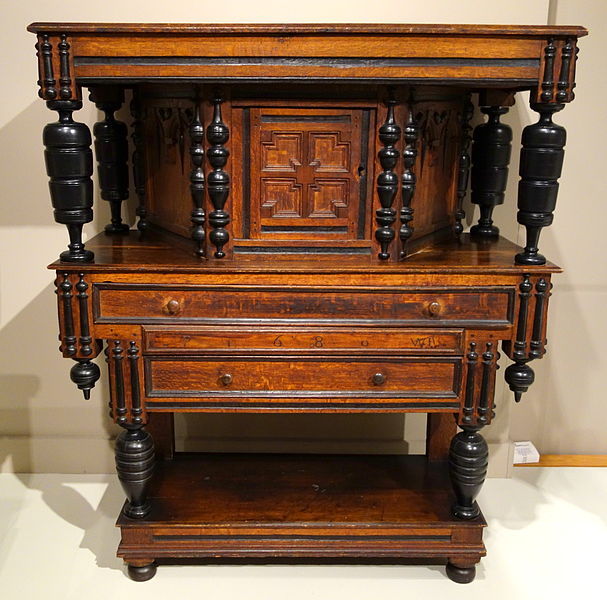Eastern Black Walnut (Juglans nigra L.) : Other Historical Uses: Dye, Wood, and Industrial Applications

Cupboard made of Black Walnut wood, possibly by Emery Shop in Newbury, Massachusetts, c. 1680. (From an exhibit in the Winterhur Museum, New Castle County, Delaware, 2013).
Throughout American history this tree has been valued, and our supplies have actually dwindled due to unsustainable use and logging. As early as 1610, settlers from the Virginia colony exported black walnut wood to England, and by the mid 18th century according to Peter Kalm, a Swedish-Finnish botanist (among other things) wrote, “Of the black walnut (Juglans nigra) there is yet sufficient quantity, but careless people are trying to destroy it, and some peasants even use it for fuel." The already minimal natural distribution in New England was furthered reduced by the small-arms industry, which further increased the demand for black walnut wood that was already treasured for other uses like making furniture and fires. This arms industry flourished on the banks of the Connecticut River in growing cities of Springfield and Worcester, Massachusetts, as well as Hartford, Connecticut . As this industry exhausted black walnut trees in New England, the gun manufacturing industry moved to Huron and Marietta, Ohio.
The black walnut tree’s rich hardwood is highly prized to make furniture: “For their finest pieces, furniture joiners sought the beautiful and rich, deep chocolate-brown heartwood of black walnut (Juglans nigra)." As the wood is exceptionally hard, it is a difficult material for inexperienced carpenters to work with, though it is actually fairly easy to split. Used to make cabinets, chairs, tables, flooring, instruments, and even caskets, this wood is durable and strong. Early settlers used black walnut wood to make posts and fences since it resisted decay. Until the early 1970’s, it was one of the most valuable woods, though its popularity decreased until around the mid 1990’s most likely due to its high cost and limited availability.
During the Civil War, Southerners would use black walnut hulls, which produced a brownish-black dye to dye their homespun clothing. The black walnuts contain a high concentration of tannins, which aid in the process of fixing the dye to fabric so it does not fade, while the chemical Juglone in the hulls serves as the dye. Families sent these homespun clothes dyed with black walnut hulls to their soldiers in the Confederate Army.
Again, during the Civil War, the tree’s wood was used in gunstocks. In WWI, the black walnut wood was used to make airplane propellers, and in WWII, the U.S. government established programs to encourage people to give their black walnut trees to the military to support the war effort. Efforts to replenish these trees were made in the 1930’s and 1940’s but they were not very successful. Eventually, the U.S. Forest Service began to develop new ways to grow the trees, and they found it useful to have private landowners grow walnut plantations. As black walnut trees are so valuable, they have actually been chopped down and poached from private property throughout the years. Ground black walnut shells are currently used for abrasives in cleaning supplies and cosmetics, cleaning metals, alloys, and plastics.

